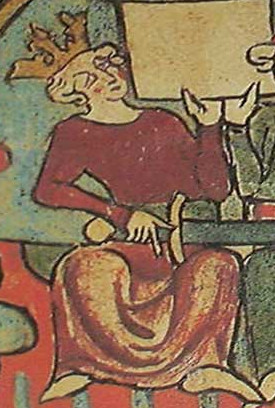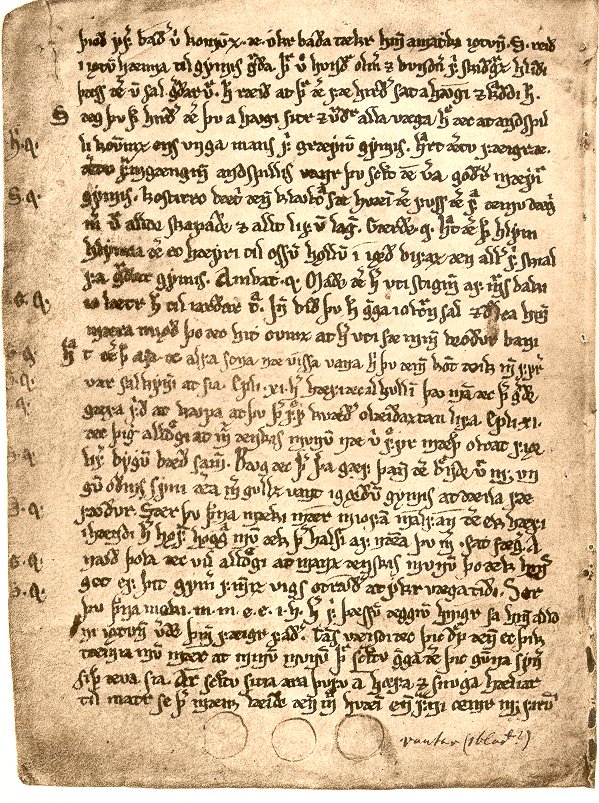|
Konráðs Saga Keisarasonar
''Konráðs saga keisarasonar'' is a medieval Icelandic romance saga. In the assessment of its editor Otto J. Zitzelsberger, it is 'a fine specimen of an early indigenous ''riddarasaga'' that combines elements from native tradition with newer and more fashionable ones from the Continent'. He dates it to the early fourteenth century. Although seen as highly formulaic by Jürg Glauser, Heizmann and Péza have argued that the saga provides a sophisticated exploration of identity. Synopsis Kalinke and Mitchell summarise the saga thus: With his foster-brother Róðbert (the son of an earl), Konráðr (son of the emperor of Saxland) who is outstanding in every respect except that he has not learned foreign languages, journeys to Miklagarðr to woo Mathilda, daughter of the king of Grikkland. Róðbert, who is skilled in foreign languages, is to speak for Konráðr, but impersonates him and sues for Mathilda's hand. Konráðr learns of the betrayal and with the advice of Mathilda—who h ... [...More Info...] [...Related Items...] OR: [Wikipedia] [Google] [Baidu] |
Romance Saga
The ''riddarasögur'' (literally 'sagas of knights', also known in English as 'chivalric sagas', 'romance-sagas', 'knights' sagas', 'sagas of chivalry') are Norse prose sagas of the romance genre. Starting in the thirteenth century with Norse translations of French '' chansons de geste'' and Latin romances and histories, the genre expanded in Iceland to indigenous creations in a similar style. While the ''riddarasögur'' were widely read in Iceland for many centuries they have traditionally been regarded as popular literature inferior in artistic quality to the Icelanders' sagas and other indigenous genres. Receiving little attention from scholars of Old Norse literature, many remain untranslated. The production of chivalric sagas in Scandinavia was focused on Norway in the thirteenth century and then Iceland in the fourteenth. Vernacular Danish and Swedish romances came to prominence rather later and were generally in verse; the most famous of these are the Eufemiavisorna, the ... [...More Info...] [...Related Items...] OR: [Wikipedia] [Google] [Baidu] |
Jürg Glauser
Jürg is the name of: * Jürg Amann (1947–2013), Swiss author and dramatist * Jürg Baur (1918–2010), German composer and teacher of classical music * Jürg Berger (born 1954), retired Swiss professional ice hockey forward * Jürg Capol (born 1965), Swiss cross country skier * Jürg Federspiel (1931–2007), Swiss writer * Hans-Jürg Fehr (born 1948), president (2004-) of the Social Democratic Party of Switzerland * Jürg Fröhlich Jürg Martin Fröhlich (born 4 July 1946 in Schaffhausen) is a Swiss mathematician and theoretical physicist. He is best known for introducing rigorous techniques for the analysis of statistical mechanics models, in particular continuous symmetry ... (born 1946), Swiss mathematician and theoretical physicist * Jürg Kreienbühl (1932–2007), Swiss and French painter * Jürg M. Stauffer (born 1977), Swiss politician * Jürg Studer (born 1966), Swiss football defender * Jürg Wenger (born 1969), Swiss skeleton racer See also * {{disambig ... [...More Info...] [...Related Items...] OR: [Wikipedia] [Google] [Baidu] |
Þjalar-Jóns Saga
''Þjalar-Jóns saga'' ('the saga of Þjálar-Jón' or 'Jón of the file'), also known as ''Saga Jóns Svipdagssonar ok Eireks forvitna'' ('the saga of Jón Svipdagsson and Eirekur the Curious') is a medieval Icelandic saga defined variously as a romance-saga and a legendary saga. The earliest manuscript, Holm. perg. 6 4to, dates from around the first quarter of the fifteenth century, and the saga is thought to be from the fourteenth century.''Þjalar-Jóns saga'' , trans. by Philip Lavender, ''Leeds Studies in English'', n.s. 46 (2015), 73-113. The saga is particularly noteworthy because chapter 3 contains , which ‘is surely unique among ''fornaldarsögur'' and ''riddarasögur''’, and al ... [...More Info...] [...Related Items...] OR: [Wikipedia] [Google] [Baidu] |
Stemma Of Konráðs Saga Keisarasonar By Alaric Hall refers to a class of simple eyes in arthropods
* Kind of empire crown in the late Roman, the Byzantine and the Bulgarian empires
{{Disambiguation ...
Stemma (plural stemmata) may refer to: * In stemmatics, an approach to textual criticism, a stemma or stemma codicum is a diagram showing the relationships of the various versions of a text to earlier versions or manuscripts * Tree-like diagrams representing sentence structure and syntax created by Lucien Tesnière * Coat of arms or arms in the Italian language *A family tree or recorded genealogy * Stemmata A simple eye (sometimes called a pigment pit) refers to a form of eye or an optical arrangement composed of a single lens and without an elaborate retina such as occurs in most vertebrates. In this sense "simple eye" is distinct from a multi-l ... [...More Info...] [...Related Items...] OR: [Wikipedia] [Google] [Baidu] |
Alaric Hall
Alaric Hall (born 1979) is a British philologist who is an associate professor of English and director of the Institute for Medieval Studies at the University of Leeds. He has, since 2009, been the editor of the academic journal '' Leeds Studies in English'' and its successor ''Leeds Medieval Studies''. Biography Hall received his B.A. in Anglo-Saxon, Norse and Celtic from the University of Cambridge, his M.Phil. in Medieval Studies from the University of Glasgow, and his Ph.D. in English from the University of Glasgow. His Ph.D. thesis was on elves in Anglo-Saxon England. He has subsequently become an associate professor of English and director of the Institute for Medieval Studies at the University of Leeds. Hall researches and teaches the languages, cultures and history of Northwest Europe in the Middle Ages. He has written and edited several works on these subjects. Hall is also an authority on Icelandic language and literature. His 2007 book ''Elves in Anglo-Saxon England ... [...More Info...] [...Related Items...] OR: [Wikipedia] [Google] [Baidu] |
Chivalric Sagas
The ''riddarasögur'' (literally 'sagas of knights', also known in English as 'chivalric sagas', 'romance-sagas', 'knights' sagas', 'sagas of chivalry') are Norse prose sagas of the romance genre. Starting in the thirteenth century with Norse translations of French '' chansons de geste'' and Latin romances and histories, the genre expanded in Iceland to indigenous creations in a similar style. While the ''riddarasögur'' were widely read in Iceland for many centuries they have traditionally been regarded as popular literature inferior in artistic quality to the Icelanders' sagas and other indigenous genres. Receiving little attention from scholars of Old Norse literature, many remain untranslated. The production of chivalric sagas in Scandinavia was focused on Norway in the thirteenth century and then Iceland in the fourteenth. Vernacular Danish and Swedish romances came to prominence rather later and were generally in verse; the most famous of these are the Eufemiavisorna, them ... [...More Info...] [...Related Items...] OR: [Wikipedia] [Google] [Baidu] |
Icelandic Literature
Icelandic literature refers to literature written in Iceland or by Icelandic people. It is best known for the sagas written in medieval times, starting in the 13th century. As Icelandic and Old Norse are almost the same, and because Icelandic works constitute most of Old Norse literature, Old Norse literature is often wrongly considered a subset of Icelandic literature. However, works by Norwegians are present in the standard reader ''Sýnisbók íslenzkra bókmennta til miðrar átjándu aldar'', compiled by Sigurður Nordal on the grounds that the language was the same. Early Icelandic literature The medieval Icelandic literature is usually divided into three parts: *Eddic poetry *Sagas *Skaldic poetry The ''Eddas'' There has been some discussion on the probable etymology of the term "Edda". Most say it stems from the Old Norse term ''edda'', which means great-grandmother, but some see a reference to Oddi, a place where Snorri Sturluson Snorri Sturluson ( ; ; 1179 – 22 S ... [...More Info...] [...Related Items...] OR: [Wikipedia] [Google] [Baidu] |

